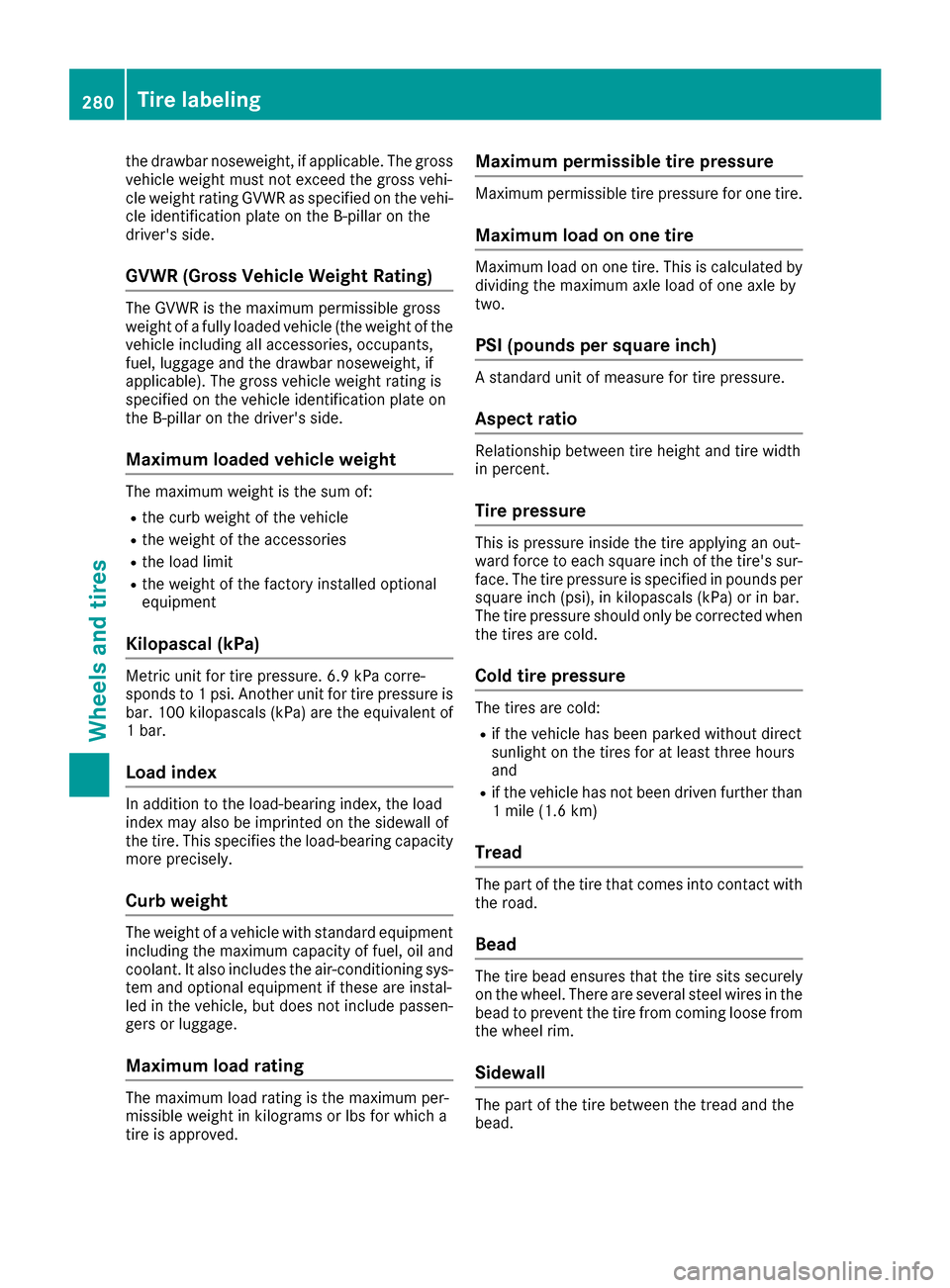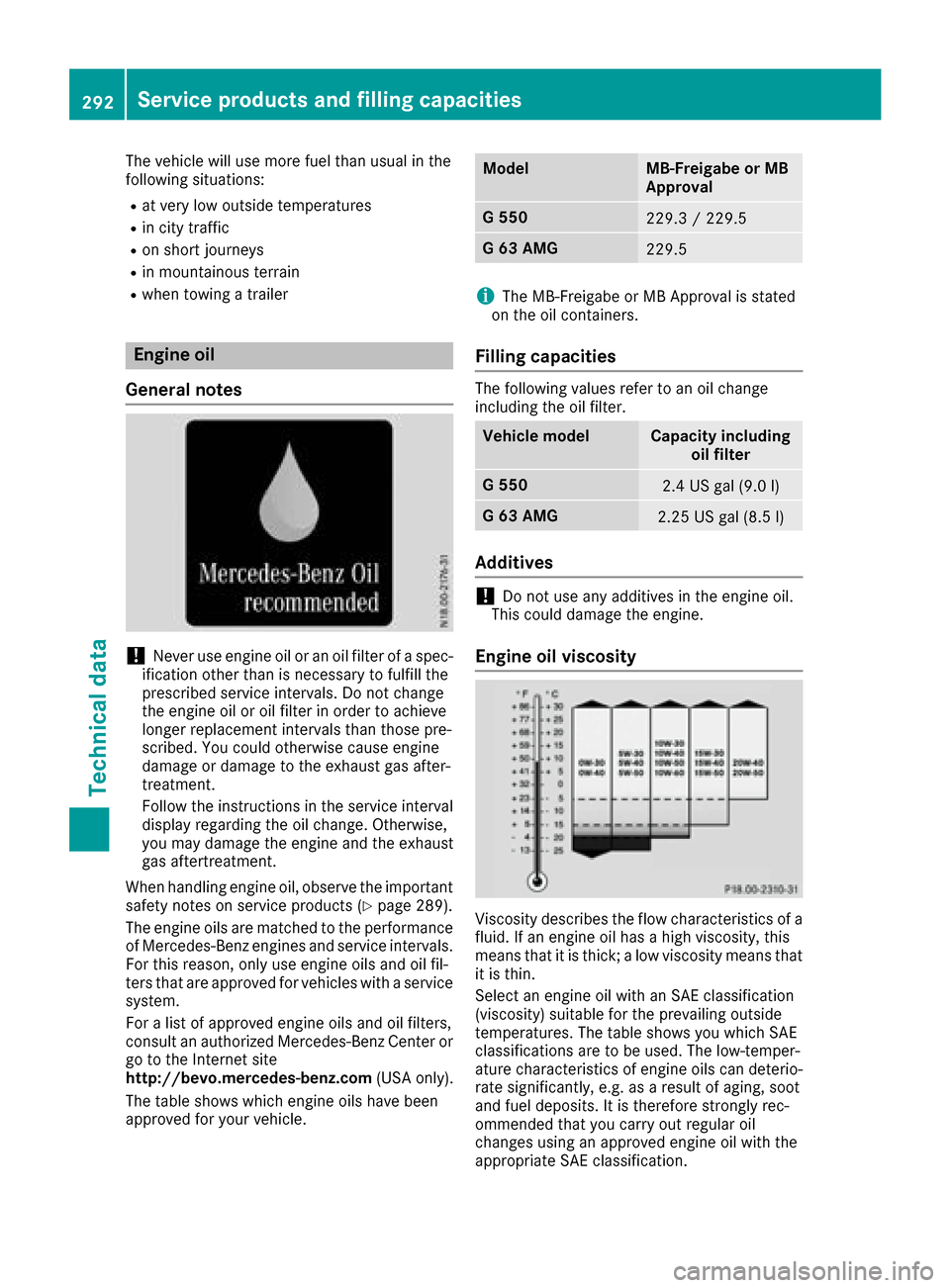2016 MERCEDES-BENZ G-Class oil capacity
[x] Cancel search: oil capacityPage 10 of 302

EngineCheck Engine warning lamp .......... .210
Display message ............................ 192
ECO start/stop function ................ 114
Engine number ............................... 289
Irregular running ............................ 117
Jump-starting ................................. 254
Starting problems .......................... 117
Starting the engine with the
SmartKey ....................................... 113
Switching off .................................. 131
Tow-starting (vehicle) ..................... 259
Engine electronics
Problem (malfunction) ................... 117
Engine oil
Adding ...........................................2 37
Additives ........................................ 292
Checking the oil level ..................... 236
Checking the oil level using the
dipstick .......................................... 236
Display message ............................ 193
Filling capacity ............................... 292
Notes about oil grades ................... 292
Temperature (on-board com-
puter) ............................................. 182
Viscosity ........................................ 292
Environmental protection
Note ................................................. 19
ESP
®(Electronic Stability Pro-
gram)
AMG menu (on-board computer) ... 182
Deactivating/activating ................... 57
Display message ............................ 185
Function/notes ................................ 57
Important safety information ........... 57
Trailer stabilization ........................... 58
Warning lamp ................................. 207
Exhaust check ................................... 133
Exhaust tail pipe (cleaning instruc-
tions) ..................................................2 44
Exterior lighting
see Lights
Exterior mirrors
Adjusting ......................................... 80
Dipping (automatic) ......................... 81
Folding in when locking (on-board
computer) ...................................... 181 Folding in/out (automatically) ......... 81
Folding in/out (electrically) ............. 80
Out
of p
osition (troubleshooting) ..... 81
Setting ............................................. 81
Storing settings (memory func-
tion) ................................................. 82
Storing the parking position ............. 81
F
Filler cap
see Refueling
First-aid kit ......................................... 248
Flat tire
Preparing the vehicle ..................... 250
Folding the seat backrest (rear)
forwards/back .................................. 217
Fuel
Additives ........................................ 291
Consumption information .............. 291
Consumption statistics .................. 173
Displaying the range ...................... 174
Fuel gauge ..................................... 171
Grade (gasoline) ............................ 290
Important safety notes .................. 290
Notes for AMG vehicles ................. 291
Premium-grade unleaded gaso-
line ................................................. 290
Problem (malfunction) ................... 130
Refueling ........................................ 127
Tank content/reserve fuel ............. 290
Fuel consumption
Notes ............................................. 132
Fuel filler flap
Emergency release ........................ 129
Opening/closing ............................ 128
Fuel level
Calling up the range (on-board
computer) ...................................... 174
Fuel tank
Capacity ........................................ 290
Problem (malfunction) ................... 130
Fuel/water separator
Service ........................................... 241
Fuse allocation chart ........................ 259
Fuse box
Battery case ................................... 260
Dashboard ..................................... 259
8Index
Page 282 of 302

the drawbar noseweight, if applicable. The gross
vehicle weight must not exceed the gross vehi-
cle weight rating GVWR as specified on the vehi-
cle identification plate on the B-pillar on the
driver's side.
GVWR (Gross Vehicle Weight Rating)
The GVWR is the maximum permissible gross
weight of a fully loaded vehicle (the weight of thevehicle including all accessories, occupants,
fuel, luggage and the drawbar noseweight, if
applicable). The gross vehicle weight rating is
specified on the vehicle identification plate on
the B-pillar on the driver's side.
Maximum loaded vehicle weight
The maximum weight is the sum of:
Rthe curb weight of the vehicle
Rthe weight of the accessories
Rthe load limit
Rthe weight of the factory installed optional
equipment
Kilopascal (kPa)
Metric unit for tire pressure. 6.9 kPa corre-
sponds to 1 psi. Another unit for tire pressure is
bar. 100 kilopascal s(kPa) are the equivalent of
1 bar.
Load index
In addition to the load-bearing index, the load
index may also be imprinted on the sidewall of
the tire. This specifies the load-bearing capacity
more precisely.
Curb weight
The weight of a vehicle with standard equipment
including the maximum capacity of fuel, oil and
coolant. It also includes the air-conditioning sys-
tem and optional equipment if these are instal-
led in the vehicle, but does not include passen-
gers or luggage.
Maximum load rating
The maximum load rating is the maximum per-
missible weight in kilograms or lbs for which a
tire is approved.
Maximum permissible tire pressure
Maximum permissible tire pressure for one tire.
Maximum load on one tire
Maximum load on one tire. This is calculated by
dividing the maximum axle load of one axle by
two.
PSI (pounds per square inch)
A standard unit of measure for tire pressure.
Aspect ratio
Relationship between tire height and tire width
in percent.
Tire pressure
This is pressure inside the tire applying an out-
ward force to each square inch of the tire's sur-
face. The tire pressure is specified in pounds per
square inch (psi), in kilopascals (kPa) or in bar.
The tire pressure should only be corrected when
the tires are cold.
Cold tire pressure
The tires are cold:
Rif the vehicle has been parked without direct
sunlight on the tires for at least three hours
and
Rif the vehicle has not been driven further than
1 mile (1.6 km)
Tread
The part of the tire that comes into contact with
the road.
Bead
The tire bead ensures that the tire sits securely
on the wheel. There are several steel wires in the
bead to prevent the tire from coming loose from
the wheel rim.
Sidewall
The part of the tire between the tread and the
bead.
280Tire labeling
Wheels and tires
Page 294 of 302

The vehicle will use more fuel than usual in the
following situations:
Rat very low outside temperatures
Rin city traffic
Ron short journeys
Rin mountainous terrain
Rwhen towing a trailer
Engine oil
General notes
!Never use engine oil or an oil filter of a spec-
ification other than is necessary to fulfill the
prescribed service intervals. Do not change
the engine oil or oil filter in order to achieve
longer replacement intervals than those pre-
scribed. You could otherwise cause engine
damage or damage to the exhaust gas after-
treatment.
Follow the instructions in the service interval display regarding the oil change. Otherwise,
you may damage the engine and the exhaust
gas aftertreatment.
When handling engine oil, observe the important
safety notes on service products (
Ypage 289).
The engine oils are matched to the performance
of Mercedes-Benz engines and service intervals.
For this reason, only use engine oils and oil fil-
ters that are approved for vehicles with a service
system.
For a list of approved engine oils and oil filters,
consult an authorized Mercedes-Benz Center or
go to the Internet site
http://bevo.mercedes-benz.com (USA only).
The table shows which engine oils have been
approved for your vehicle.
ModelMB-Freigabe or MB
Approval
G 550229.3 / 229.5
G 63 AMG229.5
iThe MB-Freigabe or MB Approval is stated
on the oil containers.
Filling capacities
The following values refer to an oil change
including the oil filter.
Vehicle modelCapacity including oil filter
G 5502.4 US gal (9.0 l)
G 63 AMG2.25 US gal (8.5 l)
Additives
!Do not use any additives in the engine oil.
This could damage the engine.
Engine oil viscosity
Viscosity describes the flow characteristics of a
fluid. If an engine oil has a high viscosity, this
means that it is thick; a low viscosity means that it is thin.
Select an engine oil with an SAE classification
(viscosity) suitable for the prevailing outside
temperatures. The table shows you which SAE
classifications are to be used. The low-temper-
ature characteristics of engine oils can deterio-
rate significantly, e.g. as a result of aging, soot
and fuel deposits. It is therefore strongly rec-
ommended that you carry out regular oil
changes using an approved engine oil with the
appropriate SAE classification.
292Service products and filling capacities
Technical data
Page 295 of 302

Climate control system refrigerant
Important safety notes
The climate control system of your vehicle is fil-
led with refrigerant R‑ 134a.
The instruction label regarding the refrigerant
type used can be found on the radiator cross
member.
!Only the refrigerant R ‑134a and the PAG oil
approved by Mercedes-Benz may be used.
The approved PAG oil may not be mixed with
any other PAG oil that is not approved for
R-134a refrigerant. Otherwise, the climate
control system may be damaged.
Service work, such as topping up refrigerant or
replacing components, may only be carried out
by a qualified specialist workshop. All applicable
regulations must be adhered to, SAE standard
J639 included.
Always have work on the climate control system
carried out at a qualified specialist workshop.
Refrigerant instruction label
Example :refrigeran tinstruction label
:
Warning symbol
;Refrigerant filling capacity
=Applicable standards
?PAG oil part number
AType of refrigerant
Warning symbol :advises you about:
Rpossible dangers
Rhaving service work carried out at a qualified
specialist workshop
Filling capacities
Missing values were not available at time of
going to print.
AMG vehiclesCapacity
Refrigerant
PAG oil
All other modelsCapacity
Refrigerant
PAG oil
Brake fluid
GWARNING
The brake fluid constantly absorbs moisture
from the air. This lowers the boiling point of
the brake fluid. If the boiling point of the brake
fluid is too low, vapor pockets may form in the
brake system when the brakes are applied
hard. This would impair braking efficiency.
There is a risk of an accident.
You should have the brake fluid renewed at
the specified intervals.
When handling brake fluid, observe the impor-
tant safety notes on service products
(
Ypage 289).
The brake fluid change intervals can be found in
the Maintenance Booklet.
Only use brake fluid approved by Mercedes-
Benz according to MB-Freigabe or MB Approval
331.0.
Information about approved brake fluid can be
obtained at any qualified specialist workshop or on the Internet at
http://bevo.mercedes-benz.com.
iHave the brake fluid regularly replaced at a
qualified specialist workshop and the replace-
ment confirmed in the Maintenance Booklet.
Service products and filling capacities293
Technical data
Z